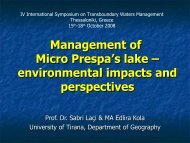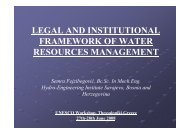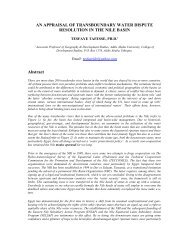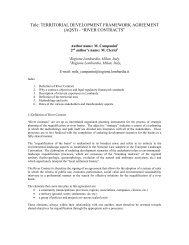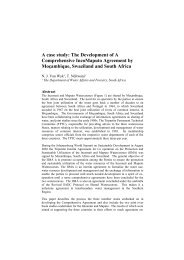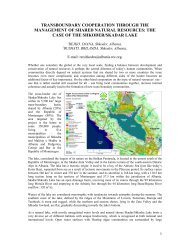Hydrology for the Environment, Life and Policy - inweb
Hydrology for the Environment, Life and Policy - inweb
Hydrology for the Environment, Life and Policy - inweb
You also want an ePaper? Increase the reach of your titles
YUMPU automatically turns print PDFs into web optimized ePapers that Google loves.
<strong>Hydrology</strong> <strong>for</strong> <strong>the</strong> <strong>Environment</strong>, <strong>Life</strong> <strong>and</strong> <strong>Policy</strong>A trans-disciplinary initiative tosolve real problems in real catchmentsProf. Shahbaz KhanWater Sciences DivisionUNESCO, ParisEmail: S.Khan@unesco.org
“Paradigm Lock”
<strong>Hydrology</strong> <strong>for</strong> <strong>the</strong> <strong>Environment</strong>, <strong>Life</strong> <strong>and</strong> <strong>Policy</strong>To deliver social, economic <strong>and</strong> environmental benefit tostakeholders through sustainable <strong>and</strong> appropriate use ofwater by directing hydrological science towardsimproved integrated catchment management basinshttp://www.unesco.org/water/ihp/helpReal people Real catchments Real answers
Achieving True Stakeholder Participation8 COMMUNITYCONTROLDEGREES7 DELEGATED POWER OFCOMMUNITYPOWER6 PARTNERSHIP5 PLACATIONDEGREES4 CONSULTATION OFTOKENISM3 INFORMING2 THERAPY1 MANIPULATIONNON-PARTICIPATIONAdapted from Arnstein (1969)
IHP VIIHP VIIHELP is an integral cross cutting activityof <strong>the</strong> UNESCO InternationalHydrological ProgrammeTheme 1 (T1)Theme 2 (T2)Theme 32 (T3) (T2)Theme 4 (T4)Theme 5 (T5)Theme 3 (T3)Theme 4 (T4)Theme 5 (T5)Adaptating Global Changes to <strong>the</strong> impacts <strong>and</strong> Water of global Resources changes onIntegrated river Watershed basins <strong>and</strong> <strong>and</strong> aquifer Aquifer systems DynamicsStreng<strong>the</strong>ning L<strong>and</strong> Habitat Water <strong>Hydrology</strong> Governance <strong>for</strong>Sustainability Water <strong>and</strong> SocietyWater Education <strong>and</strong> TrainingEcohydrology <strong>for</strong> SustainabilityWater <strong>and</strong> <strong>Life</strong> Support SystemsWater Education <strong>for</strong> Sustainable Development
Breaking <strong>the</strong> vicious cycle in integrated project managementStage 0: Stakeholder consultation & participationStage 1: Underst<strong>and</strong>ing issuesStage 2: 1: Data Action collection planStage 2: 3:Long Data term analysis monitoring <strong>and</strong> researchStage 3: 4: Modelling & scenario developmentStage 5: 4: Development Decision Support SystemsFrom Carmen deJong with PeterHerbertsonStage 6: 5: Soft Transfer recommendationsof model resultsIdentification <strong>and</strong> DSS to stakeholdersof new research needs
The HELP ProcessTwo major steps: A comprehensive assessment of what we knownow (physical, socio-economic, legal, culturalbaseline in<strong>for</strong>mation). Iteration betweenstakeholders <strong>and</strong> scientists to determine researchplan. Implementation of research in collaborationbetween scientists, managers <strong>and</strong> stakeholders.
What makes HELP unique? Only international programme thatis a catchment based activitywhich is interfacing scientificresearch with stakeholders needs. Includes scientists, stakeholders,policy-makers, lawyers. Provides options as againstimposing solutions. Providing/testing/implementing<strong>and</strong> improving solutions. Sharing experiences across aglobal network of basins.Davaopict(Davao HELP Basin)(Meeting in Kodgiball village, Western Ghats.India)
HELP GLOBAL NETWORKDemonstrationOperationalEvolvingProposed
HELP GLOBAL NETWORKDemonstrationOperationalEvolvingProposed
What has been achieved so far?Publications:HELP design <strong>and</strong> implementation strategy, 2001UNESCO IHP Series Technical Documents in<strong>Hydrology</strong> (38) 2000. An overview of selected policydocuments on water resources management thatcontributed to <strong>the</strong> design of HELP.Article in AWRA journal, 2003Special Issues of <strong>the</strong> International Journal of WaterResources Development (Vol.20, no.3) September2004 <strong>and</strong> Water SA 2008CUP Book on Water <strong>and</strong> ForestsWater Law <strong>and</strong> <strong>Policy</strong>: “The role of hydrologicalin<strong>for</strong>mation in water law <strong>and</strong> policy: current practice<strong>and</strong> future potential.”Integrated Assessment of Water Resources <strong>and</strong>Global Change A North South Analysis
Communication:• Website• Brochures• Newsletters• Database
Evolution of <strong>the</strong> HELP Network70606756 Countries5012 Proposed (2)4020 Evolving (10)3020253328 Operational (15)7 Demonstration (6)1033 « active » basins2001 2004 2007
HELP GLOBAL NETWORKDemonstrationOperationalEvolvingProposed
Countries HELP basins MAB Reserves World Heritage SitesAustralia Murrumbidgee Kulkyne Will<strong>and</strong>ra LakesAustralia Burdekin Wet Tropics of Queensl<strong>and</strong>Bulgaria/Greece Nestos/Mesta Alibotouch Pirin MountainCanada/USA Lake Champlain ChamplainFrance Rhone CamargueGermany Saale Flussl<strong>and</strong>schaft ElbeGhana White Volta Vota, Greater Accra, C <strong>and</strong> WKenyaRegionsEwazo Ng’Iro Mt Kenya Mt KenyaMorocco Draa ArganeraieOman Barka Arabian Oryx SanctuaryPanama Panama Portobelo-San LorenzoPuerto Rico Luquillo Mt LuquilloRussia Irtysh Altai MountainsSri Lanka Walawe Sinharaja ForestUruguay Tacuarembo Banados del EsteUSA Willamette HJ Andrews
Where are we heading?Integrated SciencesThe need <strong>for</strong> a paradigm shift in scientific research tosupport l<strong>and</strong>-water management issues leads to a series ofWorkshops.To complement research continuing on strictdisciplinary lines we need to take a more crossdisciplinary,more integrated approach with astrong focus on lateral fluxes, (quantity <strong>and</strong>quality) where <strong>the</strong> IHP has a lot of experience. “Carry on going vertically but also thinklaterally”Note: The systematic areas of surface water, groundwater <strong>and</strong>ecohydrological components of <strong>the</strong> IHP will contribute to HELP in<strong>the</strong> field.(Murrumbidgee HELP basinConceptual model)
The next meetings: HELP Trans-boundary Challenge. October 2008. Greece HELP Review. October 2008. Tucson HELP Evaluation <strong>and</strong> Thematic Leadership Mtg . early2009. Controls of transitional climate <strong>and</strong> l<strong>and</strong> cover regimes onflow paths <strong>and</strong> hydrological extremes. mid 2009. Ecuador The relative roles of climatic variability <strong>and</strong> l<strong>and</strong> coverchange on floods <strong>and</strong> low flows as a function of scale. mid2010
Where are we heading?Selected Challenges <strong>for</strong> HELPOverarching Question: How do we implementHELP across <strong>the</strong>spectrum of socioeconomic<strong>and</strong> socio-cultural contexts ?
Where are we heading?Selected Challenges <strong>for</strong> HELP How do we dialogue withstakeholders ?(Thukela HELP Basin, South Africa)(Murrumbidgee HELP Basin, Australia)HELP will establish an Expert Group, 2006-2007, onStakeholder dialogue including <strong>the</strong> use of experience fromHELP basins.
How do we interface <strong>the</strong> water law <strong>and</strong> policy <strong>and</strong>science ?“The last frontier”Where are we heading?Selected Challenges <strong>for</strong> HELPPicture from www.infomag.ca/nouvelles/nouvelle.asp?100.http://lastgreatplaces.org/sanpedro/geography/hydrology.htmlA new UNESCO Water Center entitled:An International IHP-HELP Centre<strong>for</strong> Water law, <strong>Policy</strong> <strong>and</strong> Sciences,at <strong>the</strong> University of Dundee, UK,under <strong>the</strong> auspices of UNESCO;was opened in July 2006
How do weundertake <strong>the</strong>necessary scientificresearch where basinscientificinfrastructure islacking ?Where are we heading?Selected Challenges <strong>for</strong> HELPWestern Ghats, IndiaWe have established a joint IHP-HELP-IAHS(PUB)-FRIEND technical liaison group, 1 st meeting, Oregon StateUniversity, November 2005
How do we developcriteria to betterdefine “vulnerable”basins to globalchange (sensitivity toclimatic variability <strong>and</strong>hydrological impactsof l<strong>and</strong> use change)?Where are we heading?Selected Challenges <strong>for</strong> HELP(Murrumbidgee HELP Basin, Australia)This question is being addressed by both <strong>the</strong> Vienna Expert Group <strong>and</strong> <strong>the</strong> joint IHP-HELP-IAHS(PUB)-FRIEND
Where are we heading?Selected Challenges <strong>for</strong> HELP How do we addressupstream-downstreamissues within IWRM fromboth a technical,management <strong>and</strong> policyperspective?From CESAP
Where are we heading?Selected Challenges <strong>for</strong> HELP How do we address scientificgaps within <strong>the</strong> Water <strong>and</strong> Food<strong>and</strong> Energy policy issue ?Source: unesco8 HELP basins are nested within <strong>the</strong>IWMI Challenge Program on Water <strong>and</strong>Food
How can we use <strong>the</strong> HELPapproach to addressnational <strong>and</strong>transboundary basinspolicy issues connectedwith intra <strong>and</strong> inter basinconflicts connected withsurface water <strong>and</strong>groundwater? (surfacewater-groundwater shouldnot be treated as separatedisciplines, <strong>the</strong>y areconnected!)Where are we heading?Selected Challenges <strong>for</strong> HELPSource: unescoEwaso Ng’iroHELP BasinLake NaivashaHELP BasinGreater RuahaHELP Basin
Global HELP Call <strong>for</strong> Phase III(2009-2013) December 2008Expressions of Interests <strong>for</strong>Basins&Thematic LeadershipFur<strong>the</strong>r Info:s.khan@unesco.orghttp://www.unesco.org/water/ihp/help



